Wiki Project: Legend of the PC Engine '90
By Mento 1 Comments
When I'm not getting wiped out by the gruesome denizens of Bloodborne's Yharnam (what the hell is up with that big electricity skeleton dog?), I like to putter around on this great wiki of ours. To maximize my productiveness and avoid burning out, I've always concentrated on a specific "project": a selection of pages that fit within a specific criteria and have an obvious end goal to work towards. Usually, these involve completing every page - essentially, ensuring it has some explanatory page text, that the release info and details are correct, and it has a sufficient number of screenshots - for a game released on a specific console during a specific year. Some of these projects have been more taxing than others - the 488 pages for the Super Nintendo's 1994, its peak year in terms of unique releases, being the most time-consuming of these so far - but each carries with it a sense of relief and satisfaction upon completion. There are side-benefits too, of course: I've learned more about the NES/Famicom, SNES/Super Famicom and TurboGrafx-16/PC Engine in my few years working on their games' pages than I had in all my previous years of video game playing put together. (I haven't quite made it to the point where I can instantly identify a Super Famicom game by its box art, but I could probably tell you that it was a pachinko game. I mean, it's very likely from a statistical standpoint.)
But hey, this is like the tenth one of these Wiki Project rundowns I've posted now. The inside baseball of how this particular wiki editor operates is small potatoes in the grand scheme of things. I only bring it up because, for the first time in a long while, potential editors might start getting excited about our wiki again thanks to the Top Men of the site and their tireless efforts to improve this enormous repository of video game knowledge by rebuilding the whole thing from scratch. Be sure to follow CBSi engineer Will Carle for more updates on how the new wiki infrastructure is coming along, and get as stoked as I am that the wiki's back in focus again.
As for this Wiki Project update, we're looking at all the PC Engine's HuCard releases for 1990. The HuCard was the first of two formats (technically five, but let's not split hairs here) that the PC Engine - otherwise known as the TurboGrafx-16 - would use for its games. HuCard is short for "Hudson Card" - Hudson being the co-creator of the system and pioneer of this particular data format, which it previously used for its MSX games - and is a small SD card-shaped cartridge that could fit up to 20mbit (or 2.5mb) of information. These cards would be quickly supplanted by the CD-ROM format of the PC Engine CD: the first system to officially support Sony's Compact Disc format. Given that the processing and graphics technology of the PC Engine wouldn't match, say, the earliest CD-ROM capable PCs let alone something like the 32-bit Sony PlayStation, these CD games were generally the same as those you saw on HuCards only with a bunch of anime cutscenes and CD music (or "redbook audio") thrown in to take advantage of the magnitudes-larger memory storage. For the time being I'm sticking to the system's HuCard format, which on its own still saw an impressive amount of use by PC Engine game producers.
The other important piece of information that explains why I'm covering the PC Engine separately from its NA equivalent is that the PC Engine saw a considerably higher number of releases overall. The TurboGrafx-16 crashed and burned in North America after putting up a brave fight for a couple of years against the far more popular NES and Sega Genesis (and, shortly after its North American release, the Super Nintendo) and was only available in Europe in extremely small quantities for serious collectors. As such, North America barely saw a fraction of the system's total library: one that, when both formats are combined, is around 650 total releases compared to the TurboGrafx-16/TurboGrafx-CD's paltry 138 (with about 100 overlapping). I realized that not only did I have to take the PC Engine games separately, but I'd need to focus on one format per year for Wiki Projects of an approachable length.
One last thing before we begin with what I consider to be the ten most "interesting" (by various definitions of that wonderfully ambiguous word) Japan-exclusive PC Engine games in 1990: I've attached a separate list of ten Japan-exclusive games that, were their overseas licensing issues resolved and localizations paid for, would've really helped the TurboGrafx-16 stay afloat a little longer. This list of games, which I've dubbed Why Was This Not a Thing? (or "WWTNaT?") are those that would've resonated with the North American market in one way or another, offering familiar names and Arcade conversions that would've garnered at least some sales, even if the ports in question might not rank compared to the real thing - or even to the Genesis versions where applicable, given that system's extra power. Back in 1990, the TurboGrafx-16 really needed this window to acquire every video game household name it could get its hands on before another vastly superior competitor (the NA SNES launched in August of 1991) came along to sink it for good.
Top Ten "Interesting" Games
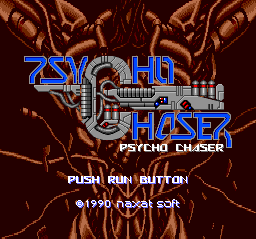 | Psycho Chaser: There's simply far too many quality shoot 'em ups for the PC Engine to choose from: it was the specific genre that the system was best known for, a mantle that would be later taken up by the similarly doomed-to-fail Sega Dreamcast. I've never been a shoot 'em up fan myself, so for my money the best games from this category are ones that tried something a bit different. Psycho Chaser looks and feels like a standard vertical shoot 'em up but for the fact that your protagonist isn't so much a ship than a giant gray cyborg striding across the landscape like the Giant of Babil from Final Fantasy IV (deeeeep cut). The game has a curious pedigree to go with its bizarre premise: it was the first game to be produced by Sting Entertainment. Sting's best known these days for their borderline incomprehensible portable strategy games like Yggdra Union, Riviera: The Promised Land and Knights in the Nightmare. They still make Sony-exclusive JRPGs and strategy games to this day. While the game's steel colossus is a little awkward to control, the nascent development team had their keen sense of balancing odd presentations with surprisingly solid gameplay, and Psycho Chaser seems to be well-regarded by genre fans if only for being a little different from the norm. As well as our wiki page you can also read HardcoreGaming101's more extensive retrospective here. (04/06/1990.) |
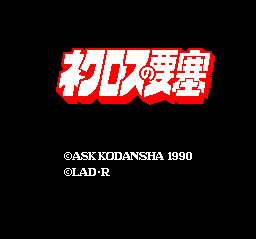 | Necros no Yousai: The PC Engine also saw a number of JRPGs, almost none of which made the transition overseas. Japanese companies were still in their "Do Westerners like JRPGs? Do they even understand them?" phase at this point, with Squaresoft soon to test the waters with an easier version of Final Fantasy IV and the disappointingly basic Final Fantasy: Mystic Quest. Dragon Warrior/Quest, the biggest franchise in Japan, had to be given away in issues of Nintendo Power to reach an audience. This was all nonsense, of course: RPGs had been a cornerstone of the Western computer gaming market for many years before a young Yuji Horii got so enamored with Wizardry that he tried to replicate it with grinning slimes, but for some reason JRPGs simply weren't seen as a reliable export for the longest time. With Necros no Yousai though, there was an additional complication: the game is based on a set of small collectible figurines (like, say, M.U.S.C.L.E.) that were sold along with candy to Japanese schoolchildren. While the game itself is fairly basic - the archetypal turn-based JRPG by most metrics - it had a goofy sense of humor that, even divorced from its toyline context, might have appealed to a Western market. The game moved at a clip, was filled with silly dramatic cutaways and cartoonish graphics, and it's not like the TurboGrafx-16 had anything much like it. But hey, try being the guy who suggests localizing a game based on Japanese toys to an American audience. (04/20/1990.) |
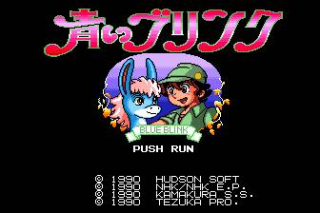 | Aoi Blink: Talking of licensed games, Aoi Blink was the last anime series ever created by Osamu Tezuka who, despite being regarded the Godfather of Manga, was never facetiously seen calling anime a mistake by a Tumblr meme. That's gratitude for you. A young boy, a spoiled princess, a world-weary bus driver and two escaped convicts cross the world to look for the boy's father, helped along the way by the eponymous blue donkey of some significant magical power. It played like a cutesy anime version of Jayce and the Wheeled Warriors: the missing father continued to elude the party's grasp week after week, though they would frequently learn lessons along the way and regularly foil the schemes of the series' mysterious villain and his underlings. The game of the anime series, curiously enough, would depart from the rigid narrative of the anime in a significant manner. Not in terms of where the story was going, but in how the player could proceed through its many stages in any order they chose: a lot of them were optional, and the player needed to find the right one to acquire the key to the world's boss. Stages were linked by distinct exits from stages with multiple branches on the overworld, in a fashion very similar to Super Mario World (which, by April 1990, was still a few months away). Not only did the player have to find the right exit to head to their desired stage, but they would sometimes have to double back and try a different route if the first one didn't lead anywhere. It's not quite the confusing maze I'm making it sound, as the stages would often loop back around, but it was one of the first side-scrolling platformers to explore such a non-linear progression. Possibly for this reason, it was one of the first non-JRPGs for the PC Engine to see a fan translation. (For more detail, check out the TurboMento-12 article I wrote about it.) (04/27/1990.) |
 | Download: It wasn't until around this era that shoot 'em ups started getting a little more elaborate with their presentations. Generally speaking, the most you saw story-wise was a single screen of text that told you that you were the last remaining starship pilot who could repel the hordes of the alien invaders led by "Borbulox of the Rigellian Empire" or some such before dropping you in the figurative shit. This game instead opens with a grisly animated opening cinematic of two "cyber-deckers" escaping some unknown base before one of them is captured and horribly mauled by sentient computer cables in a scene reminiscent of this nightmare fuel right here. The other cyber decker wakes up in a cold sweat - it was just a dream! Or maybe PTSD from a past event - but is soon forced to go into action to rescue his new partner from her unfortunate fracas with the local corrupt law enforcement of the cyberpunk dystopian city of Kabukicho. So opens the ambitious Download and its Snatcher-esque aspirations. The game itself is a side-scrolling shoot 'em up, albeit one where you're riding around on a flying motorcycle with could be customized between stages. This motorcycle isn't just your conveyance for the city's streets: it's also the means in which the player character, Syd, can hack into computers and ride around its circuitry in a suspiciously identical fashion. The game has style to spare - not to mention some very grown-up Engrish messages in its game over screens - and certainly makes an impression in the sea of shoot 'em ups that the PC Engine was host to. (06/22/1990.) |
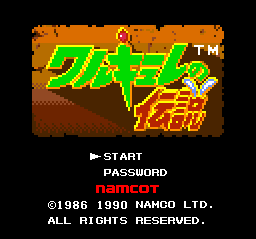 | Valkyrie no Densetsu: One of Namco's most beloved legacy characters is one that never got her due outside of Japan. Valkyrie and her games were, roughly speaking, Namco's attempt to take on the Zelda series. Valkyrie no Densetsu, or Legend of Valkyrie, is perhaps the peak of this series. It plays far more like a top-down shooter than games of its ilk - it's more Pocky & Rocky than A Link to the Past in that respect - but it has an impressive amount of depth for an Arcade game made in the 1980s. Leaving the beaten path is the best way to earn money and find new spells, both of which makes the later stages considerably easier, and the game's packed with incidental NPC dialogue to give the world and its characters some depth. Legend of Valkyrie was eventually localized (half-assedly) for the West with one of those PS1 Namco Museum Arcade compilations, though this PC Engine game was the first home version ever produced. Valkyrie would continue to make periodical cameos in future Namco games, especially in the Tales series and crossovers like Project X Zone, and is one of the earliest strong female protagonists in a video game. Strong in the sense that they actually give her some characterization, at least. (08/09/1990.) |
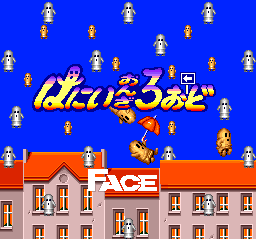 | Hany on the Road: I started the PC Engine 1989 Wiki Project with a weird little shoot 'em up featuring a Japanese clay haniwa figurine: the nonplussed (by its actual definition) arms-waving statuettes that would later inspire Animal Crossing's gyroids and Final Fantasy's cactuars. With the exception of its multi-directional aiming, Hany in the Sky was fairly standard once divorced from its visuals. Hany on the Road is its sequel and makes far better use of its eccentric presentation by coupling with equally eccentric gameplay. Hany now sprints across the landscape by quickly switching between four lanes to avoid enemies and pitfalls, in a track & field spin on Excitebike. Hany can backflip to hit enemies, but this backflip has such limited range that it's often too much of a gamble to rely on: if you miss, the enemy just steamrolls right over you. It becomes a game of rapidly switching lanes, Frogger-style, to reach the end of the game's many very disparate zones. FACE would continue to experiment in this way for many of their PC Engine games, playing around with silly themes and gameplay modes both, though Hany's perhaps the closest they ever came to having a mascot character. It's a shame his adventures ended here. (09/07/1990.) |
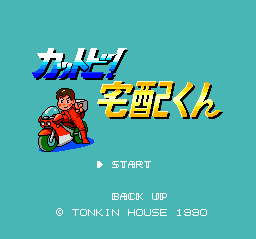 | Kattobi! Takuhai-Kun: I bring up Kattobi! Takuhai-Kun, which roughly translates to Fury! Delivery Boy!, because of its appearance on GameCenter CX. In fact, I already wrote quite a bit about it when I covered the GameCenter CX Wiki Project from a few years back. It's a game of many hidden depths; its presentation of a GTA-style top-down vehicular city exploration package delivery game revealing very little of the abnormality to come. The player has a limited amount of options for customizing their bike - it is a non-combatative game, after all - but the little missions they must perform to earn their paychecks get increasingly unhinged, eventually putting them at odds with both the mafia and the police through no fault of their own. Like Paris-Dakar Rally Special!, it's one of those GCCX episodes that comes highly recommended by me because the games themselves never stop being surprising and weird. Half the fun of GCCX is watching Kacho Arino be confounded at games you already mastered decades ago (well, for the older viewers anyway), but it's even more fun when it's a game you know nothing about that manages to perplex you to an equal extent. (11/09/1990.) |
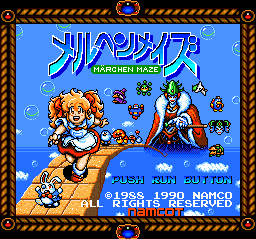 | Märchen Maze: Märchen Maze is actually the second of two Alice in Wonderland games released within a week - the other being Fushigi no Yume no Alice (which I've already covered in an Octurbo). Märchen Maze is perhaps the most interesting of the two as well; a Namco top-down shooter which you can only lose by getting knocked off the precarious floating platforms of each world. Enemy attacks knock you back, and potentially off the world, and you can fall off yourself if you're not careful with the precise platforming sequences. Boss fights often come down to avoiding the boundaries at all costs, even if that makes it easier for the boss to hit you in the process. Starting as an Arcade game, the PC Engine port makes the curious decision to "straighten" the Arcade game's vaguely isometric perspective into a standard cardinal direction top-down view. It's a bit of a shame to lose an element that made Märchen Maze so distinctive, but beyond that it seems to be a fairly faithful rendition of the original. (12/11/1990.) |
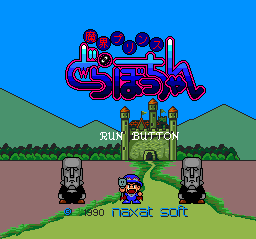 | Makai Prince Dorabocchan: For my own sake, I'm adding Makai Prince Dorabocchan to this list because I adore its sequel: the SNES game Chou Makai Taisen: Dorabocchan, released over here as The Twisted Tales of Spike McFang. An imaginative mix of a top-down shooter and a Zelda-like puzzle-filled action-adventure game, Spike McFang was one of Super Nintendo's great hidden treasures. Dorabocchan isn't quite as unique - it's a relatively straightforward 2D side-scrolling platformer with some magic thrown in - but it's the start of the pint-sized vampire and his adventures and also features various characters from that SNES original like the stalwart Moai head butlers, who in this game serve as stepping zones for secret areas and other useful places. Oddly enough, Spike McFang wasn't the last time we saw Red Company's little nipper: he would also appear in his own Super Famicom golf game, of all things. (12/21/1990.) |
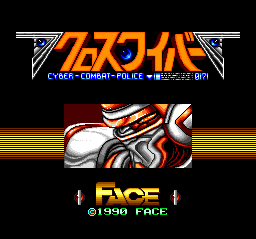 | Cross Wiber: Cross Wiber is the far more badass sequel to the action game Cyber Cross and plays like a cross between Mega Man and something a bit slower and brawler-ier like Altered Beast. As the player makes their way across various sci-fi settings in their cybernetic Cross Wiber suit, they can acquire power-ups by whacking robots that float by. There's also air-bike stages and no end of villains to fight, as they progress. Honestly, though, I bring this up because it's like the fifth or sixth game for the system that isn't based on an existing tokusatsu franchise (like, say, Super Sentai or Kamen Rider) but heavily borrows and even mildly parodies the same beats. Wonder Momo, Cyber Cross, the Shubibinmen games and Bravoman: they all have a similar subversive streak behind their otherwise pitch-perfect ersatzes of superhero TV shows that never were. Just a weird little undercurrent running behind a lot of Arcade/PC Engine games released around the same time, a bit like how every other big open-world game being released this year has a prehistoric setting (or a post-post-apocalyptic setting that manages to swing back around to prehistoric). (12/21/1990.) |
WWTNaT?
 | Space Invaders: Fukkatsu no Hi: A Space Invaders revitalization - its subtitle literally means "Day of Resurrection" - which also includes a faithful recreation of the Arcade original. I'd think that was a pretty easy sell, even in 1990. The "enhanced" mode isn't all that injurious to the overall experience, unlike a few other attempts to reboot classic Arcade games, and it's not like there hasn't been a lot of really well-received Space Invader revamps in recent years. (03/02/1990.) |
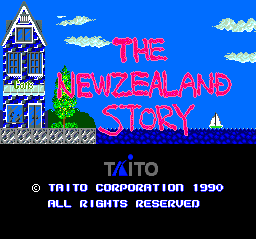 | The New Zealand Story: Taito's 1988 Arcade Kiwi 'em up is a much-loved NES and home computer game outside of Japan: another of Taito's successes with cutesy platformers to follow in the likes of Bubble Bobble and Rainbow Islands. The PC Engine version looks a bit sharper than its NES contemporary and certainly a lot more colorful. (02/23/1990.) |
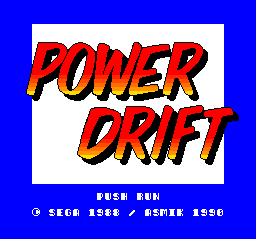 | Power Drift: Sega's vertiginous sprite-scaling racer is hard to get right on anything less than the Arcade hardware it was built for, but I recall the Atari ST version doing all right in spite of everything. As with OutRun, below, folk were all over Sega's fast-paced games. Then again, it's not like Sega wasn't also the TurboGrafx's biggest competitor. (04/13/1990.) |
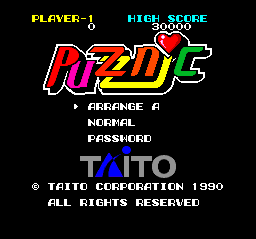 | Puzznic: Puzznic doesn't have the staying power of a falling block game like Tetris, but it's a sneaky puzzle game that's simple to understand but gets far harder than it looks in its later levels. It's another game that came out on practically every other system over here too, so I can't see licensing being a big issue. (06/29/1990.) |
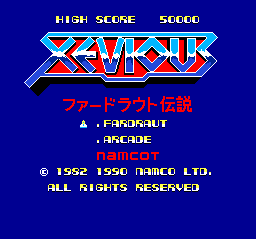 | Xevious: Fardraut Densetsu: As with Space Invaders: Fukkatsu no Hi, this is an enhanced version of Xevious that retroactively adds in various shoot 'em up innovations like power-ups and a bigger focus on story. It doesn't really do the main game a whole lot of harm, and for those who own the NES Xevious a better looking version with more enhancements would be an enticing prospect. (06/29/1990.) |
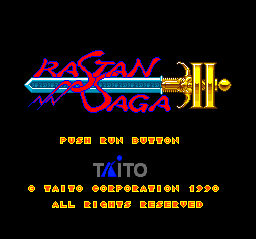 | Rastan Saga II: Perhaps because its forebear didn't see a PC Engine release or maybe because it's another franchise tied up by Sega and the Genesis overseas but this barbarian side-scroller would be one of many games to inspire Volgarr the Viking, so it presumably had its fans back in the day. It's a bit awkward as these side-scrolling action games go, but why not leverage that Legendary Axe push and make yourselves THE console for heroic dudes without shirts? (07/06/1990.) |
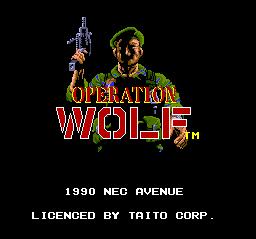 | Operation Wolf: Naturally, not having a light gun attachment limits the appeal of Operation Wolf somewhat, but it's still a military on-rails first-person shooter and if you can't sell those in the US then where can you?(08/31/1990.) |
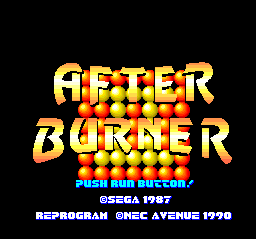 | After Burner II: Another sprite-scaling Sega Arcade game, another fairly OK port that's easily outclassed by its Genesis equivalent. Still, though, wouldn't hurt to try. (09/28/1990.) |
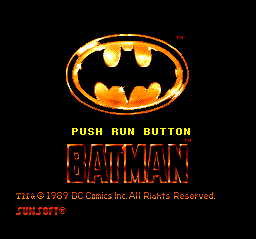 | Batman: This Batman game isn't anything like SunSoft's others, which were more side-scrolling action games with some clever traversal business and some entirely off-script additions to Burton's movie. Rather, it's a weird little maze game that I covered in an Octurbo a few years ago. Even so, Batman's an American comic book institution and that movie was doing gangbusters, so why not throw it a US TG16 release to go with its NES and Genesis cousins? It even has its own remix version of Streets of Desolation! (10/12/1990.) |
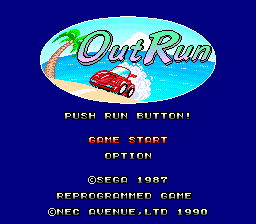 | OutRun: OutRun is in the running for one of Sega's most popular Arcade games of all time, a behind-the-car racing game that had a lot of aspirational appeal with its red convertible zipping up and down the American west coast and took serious advantage of the sprite-scaling tech that Sega would use to dominate the Arcades for much of the late 80s. Again, it's probably a small matter of not giving your competitors all your best stuff to license, but were they really worried about the TurboGrafx-16? Let them have something! They're dying out there! (12/21/1990.) |
That'll do it for this Wiki Project round-up, and for the PC Engine for quite a while. It's the Super Nintendo's turn next, and I don't imagine I'll be done with its 1995 release schedule until possibly the end of the year. I continue to find the PC Engine fascinating. It's like the 16-bit generation's version of dark matter: it was subtly affecting the fabric of that generation's trends and influences but not in any way that we over in the US and Europe could easily observe. I'll return to it, and the games it saw in 1991, at some point in the future.
Until next time, thanks for reading and be sure to keep an eye on those new wiki update blogs. Who knows? We may even get Wiki Tasks back one day and I can get a bunch of randos to do all this work for me! Vacation time!
